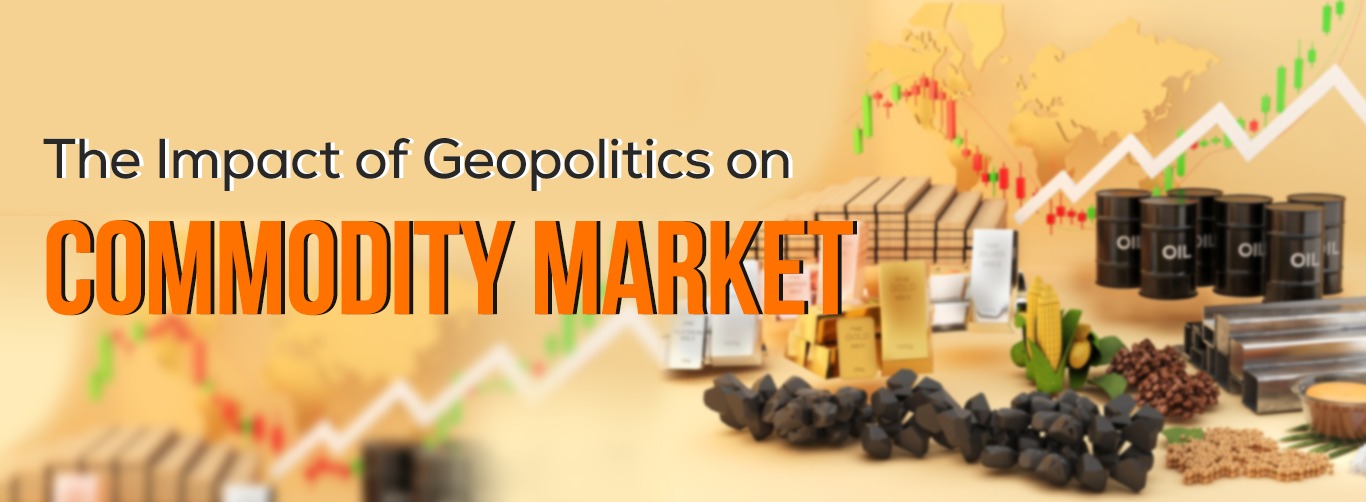Geopolitical risks threaten the supply and demand of commodities, significantly affecting their prices. Events like trade wars, civil unrest, and regulatory changes disrupt the commodity supply chain and pricing, fragmenting trade. For example, the World Bank projected that any further conflict escalation in the Middle East could significantly increase Brent crude oil prices to $92 per barrel, which would contribute to rising global inflation.
When geopolitical risks increase, regions that produce primary commodities modify their supply policies, raising supply uncertainty. This leads to a simultaneous increase in price volatility. As demand competes for limited supply, prices may rise even further. If you’re trading commodities, it’s important to stay informed about the impact of geopolitics on commodity market.
This article examines the impact of geopolitics on commodity market. Read on to learn how recent regional disruptions affect commodity market prices and trade.
How Geopolitics Impacts Commodity Market
1. Supply Chain Disruption
Geopolitical events can significantly disrupt supply networks, which directly affect commodity market. For example, areas rich in resources often experience political instability, which throws their commodity supply off balance, leading to reduced production or a complete halt in supply.
Consider the Middle East, a major global oil-producing region. If civil unrest erupts, it negatively affects mass oil production. An example of this was the 2010 Arab Spring, which crippled oil exports and caused prices to skyrocket. Venezuela, too, has been plagued by political upheavals, which have hindered its oil production.
This reduction in supply fuels market uncertainty, leading to price volatility. As a result, traders may add a risk premium to the traded commodity, driving prices even higher. They typically do this to hedge against potential shortfalls in supply in the future.
2. Currency Value Appreciation or Depreciation
When the currency of a net importer appreciates or depreciates, it affects that country’s purchasing power. Simply put, a weak currency can drive up commodity market, and vice versa.
For instance, if the Indian Rupee (INR) appreciates against another currency, an international buyer purchasing a commodity priced in INR will find it more expensive. Over time, the demand for that commodity may shrink as exports decline due to comparatively high prices.
Political instability also affects currency values. A case in point is Brexit, which caused significant fluctuations in the British pound. The weakening of the pound sparked investor interest in gold and other safe-haven commodities like oil as investors sought to hedge against currency risks.
3. Tariffs and Trade Policies
Trade policies are geopolitical strategies that can cause commodity prices to fluctuate. Take the trade war between China and the United States in 2018 as an example. Both countries imposed strict tariffs on each other’s imported commodities, affecting the prices of primary goods like pork and soybeans.
China, for example, is one of the leading importers of soybeans from the United States. When China imposed heavy tariffs on this commodity, the U.S. had to find alternative markets for its product, often at lower prices due to an excess of supply. This illustrates how trade barriers can create inefficiencies in the commodity market, leading to price fluctuations.
4. Military Actions or Conflicts
Conflicts and military actions can significantly affect commodity market by disrupting the production and distribution of goods. Lower production leads to global shortages, causing prices to soar. For instance, Mali, a country rich in gold, has faced numerous challenges in its mining operations due to political turmoil. These bottlenecks can cause gold prices to surge in global markets.
5. Sanctions and Embargoes
A country facing sanctions is unable to export its key commodities optimally, leading to regional supply shortages and increased prices. A classic example is Iran, which has faced multiple rounds of U.S. sanctions. These sanctions severed Iran’s connections with existing customers, forcing it to seek alternative oil buyers at discounted prices.
Another example is the Russia-Ukraine conflict, which has affected the sale of energy and agricultural commodities. This has caused significant price volatility due to restricted markets. Similarly, embargoes can completely ban trade with specific countries, leading to sharp price shifts.
6. Transportation and Infrastructure Disruptions
Infrastructure is a crucial part of the supply chain network. Any disruption, such as natural disasters or political chaos, affects global supply. The result is increased shipping costs, which are then passed on to consumers in the form of higher commodity prices. This is particularly noticeable in sensitive commodities like oil and perishables.
One notable example occurred in 2021 when the Suez Canal, a critical global shipping passage, was blocked for six days. This led to significant shipping delays, and the resulting temporary hoarding of goods caused oil prices and shipping costs to escalate. Similarly, land transportation delays caused by regional civil wars can create localized commodity shortages, driving up prices.
Conclusion
Geopolitical factors shape commodity prices, with effects that start at the supply chain level and lead to market volatility. As nations grapple with unprecedented pressures, investors should stay informed about geopolitical developments that may impact commodity market. This allows them to mitigate investment risks and seize opportunities in real time.
Research thoroughly before investing in commodities like agriculture, oil, gold, base metals, or energy. At Findoc, we recommend diversifying your commodities portfolio to minimize risks. Start commodity trading today!

Leave a Reply